3D-Druck im Kampf gegen COVID-19
Angesichts der aktuellen Notsituation, die aufgrund der Ausbreitung des COVID-19 herrscht Coronavirus entstehen aus Solidarität und Innovation großartige Initiativen und Lösungen, insbesondere um den Mangel an medizinischer Ausrüstung und persönlicher Schutzausrüstung (PSA) zu lindern.
Aus dem 3D-Druck In der Branche gibt es viele Ingenieure und Materialhersteller, die zusammen mit Medizinern Modelle von PSA (persönliche Schutzausrüstung) entwerfen, die dazu beitragen, die Gesundheit von Toiletten zu erhalten und ihre Arbeit zu erleichtern, so wie bei der Entwicklung verschiedener Prototypen wie z Ventile, Anschlüsse von Beatmungsgeräten oder unterstützten Beatmungsgeräten und anderen Geräten, die dazu beitragen, den Mangel an medizinischer Ausrüstung zu mildern.
Darüber hinaus gibt es viele Maker-Communities haben ihre 3D-Drucker zur Herstellung dieser Geräte auf den Markt gebracht. In Spanien ist die Coronavirus Makers-Initiative entstanden, eine gemeinnützige Plattform mit Tausenden von Freiwilligen. Ähnliche Initiativen gibt es in Ländern wie Deutschland, Italien, Chile, Argentinien oder Kolumbien.
Nachfolgend stellen wir verschiedene Designs von Schutzausrüstung und medizinischem Zubehör zusammen, die der Öffentlichkeit von verschiedenen Unternehmen und Verbänden kostenlos zur Verfügung gestellt wurden und im STL-Format heruntergeladen und auf praktisch jedem FDM-Drucker ausgedruckt werden können.
Es ist zu beachten, dass einige der Modelle nicht von den entsprechenden Gesundheitsbehörden homologiert oder zugelassen sind und dass die Herstellungsanforderungen zum Erreichen dieser Homologation je nach Region oder Land unterschiedlich sein können.
Gesichtsmasken
Sowohl auf 3D-Druckressourcenplattformen als auch auf verschiedenen Seiten von Unternehmen im 3D-Sektor werden verschiedene Maskenmodelle für den 3D-Druck auf jeder Art von 3D-FDM-Drucker geteilt.
Hervorzuheben ist, dass diese Masken , abgesehen davon, dass sie über die erforderlichen Filter verfügen, dienen nur als physische Barriere gegen das Virus , und hilft außerdem, es im Falle einer Infektion nicht zu verbreiten.
Vor ein paar Tagen haben wir das Design der von Copper3D entwickelten Nanohack-Maske geteilt Team und die kürzlich das Update des Designs dieser Maske geteilt haben:NanoHack 2.0, mit einer Monoblock-Struktur, stark und hermetisch , die mit antibakteriellen PLActive- und MDFlex-Filamenten hergestellt werden müssen, um maximalen Schutz gegen die äußere Umgebung zu bieten.
PLActive ist ein recycelbares und biokompatibles Polymer, das ein Kupfer-Nanokomposit enthält, das antimikrobielle Eigenschaften gezeigt hat.
Dank seines Designs ist NanoHack 2.0 ist ein Gerät, das Schutz vor Partikeln in der Luft bietet und die Ausbreitung von Flüssigkeiten verhindert, die die Atemwege kontaminieren. NanoHack verwendet das gleiche Material, das in chirurgischen Masken (Vliesstoff aus Polypropylen) als Filtersystem verwendet wird. Für optimalen Schutz wird die Verwendung eines dreilagigen Polypropylen-Vliesfilters empfohlen. Dieser Filter ist in die Maske eingebettet. So wird nach verschiedenen Studien ein Abscheidegrad von 96,4 % für Mikroorganismen von 1 Mikron und 89,5 % für Mikroorganismen von 0,02 Mikron erreicht.
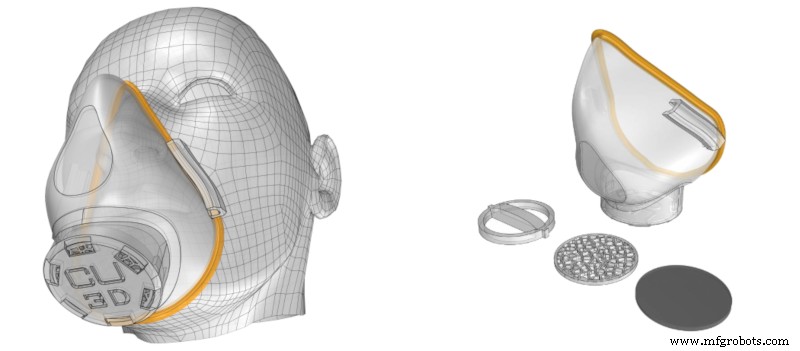
Weitere Informationen
STL herunterladen
Gesichtsschutz
Sie finden unzählige Modelle von Visieren und Gesichtsschutzschilden im Internet. Prusa hat mehrere Prototypen entwickelt, die mit dem tschechischen Gesundheitsministerium verifiziert wurden. Schließlich haben sie zwei Bildschirmversionen vorgestellt:RC1 und RC2.
 This screen design consists of a rigid structure with a flexible and transparent acetate plastic sheet. The rigid structure is 3D printed and the plastic acetate sheet is then adapted as a screen. The RC1 version allows more parts to be printed in the same printing process, while the RC2 version provides slightly higher protection and is more comfortable to wear.
This screen design consists of a rigid structure with a flexible and transparent acetate plastic sheet. The rigid structure is 3D printed and the plastic acetate sheet is then adapted as a screen. The RC1 version allows more parts to be printed in the same printing process, while the RC2 version provides slightly higher protection and is more comfortable to wear.
As a screen, the prototype uses a 0.5mm thick PETG sheet, although other transparent and flexible materials with a similar thickness can be used such as clear acetate sheets.
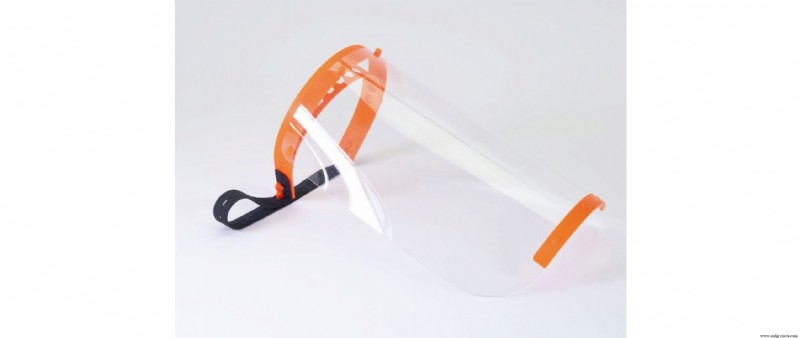
More info
Download STL from Prusa
3D printing with PETG with 30 % fill is recommended, although other materials such as PLA or ABS can be used. In order to deliver them to health centers, it's essential to sterilize them by applying a water bath with bleach (Ratio 50:1) and then rinse them with water. In this way, they will not carry the risk of possible indirect transmissions for healthcare personnel.
Respirators and valves
Given the shortage of self-contained respirators, several groups of engineers, in collaboration with different institutions and healthcare personnel, are developing prototypes and manufacturing the different parts that compose them using 3D printing.
This is the case of the Barcelona Free Trade Zone Consortium that, together with HP, Leitat, and SEAT, have developed a prototype of a respirator using 3D printing to manufacture its parts and taking advantage of elements such as a car's windshield wiper motor. This device has been named OxyGEN and has already been validated by experts from the Parc Taulí hospital in Sabadell. One of the advantages of this device is that its production is scalable.
Another possible solution that arises is to use adapters that allow the same respirator to be used for several patients, such as the “H” connector that Copper3D has developed. A design that minimizes dead space volume and prevents possible air leakage due to unnecessary connections. Copper 3D recommends 3D printing of this device using PLActive, for its antibacterial properties and biocompatibility.
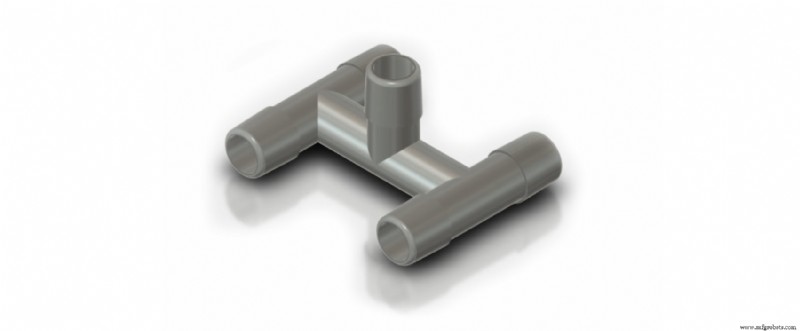
Más información
Download STL
In several hospitals there is a lack of some important elements related to respirators and necessary when treating a patient with respiratory complications. This is the case of the Venturi valve , used to regulate the oxygen concentration that is introduced to the patient through the respirator.
There are several designs available to users, such as this one from the Cults platform.
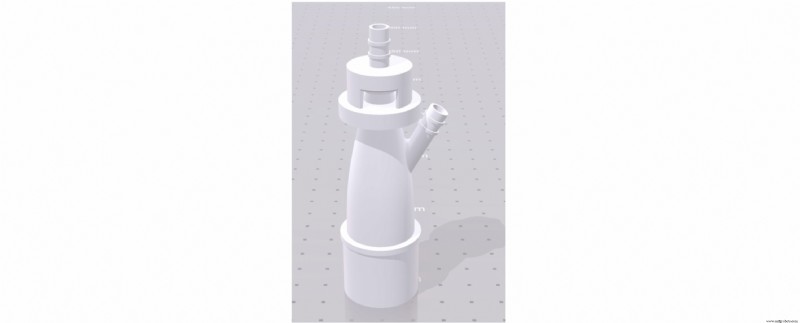
Download STL from Cults
Other devices
In addition to PPE and specific devices for the treatment of patients affected by COVID-19, different tools are being developed to avoid the contagion by indirect contact to which anyone is exposed in their daily activity (door and window handles, buttons for elevators, etc.).
The StopCovid-19 ring is an easy to print ring, designed to press switches and buttons without physically touching them.
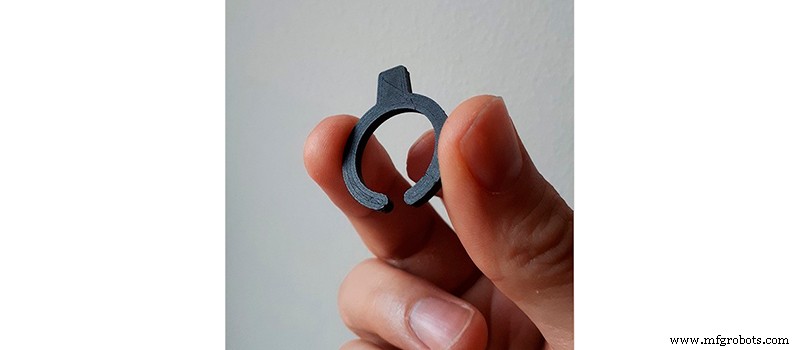
Download STL from Cults
Companies like Materialise have developed a device for attaching to door handles, so that they can be opened without using your hands. Different versions of this tool, adapted to different handle formats (cylindrical, rectangular, circular, etc.) can be downloaded free of charge from its website.

Download STL from Materialise
Combining the usefulness of the previous two, there is LU-Touch :A tool for opening and closing doors and windows, and at the same time a push-button for buttons and switches. LU-Touch can be downloaded for free and printed on any 3D FDM printer. In addition, if you do not have a 3D printer, it can be purchased already printed.
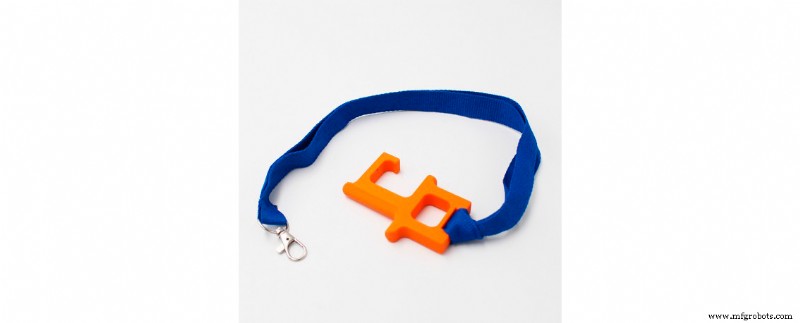
Download STL from Thingiverse
Thanks to the use of these tools, it's possible to minimize the possibility of contagion due to indirect contacts in daily activity. For greater safety, it's necessary to disinfect the tools always after use. It should also be remembered that the use of this type of tool does not exempt from applying the recommended safety rules:wash your hands regularly, do not touch your face, etc.
Specific materials
Among the specific materials to manufacture personal protective equipment, we highlight PLActive and MDFlex for their antimicrobial and antiviral qualities. This material is also recommended for printing expansion devices and valves adapted to self-contained respirators.
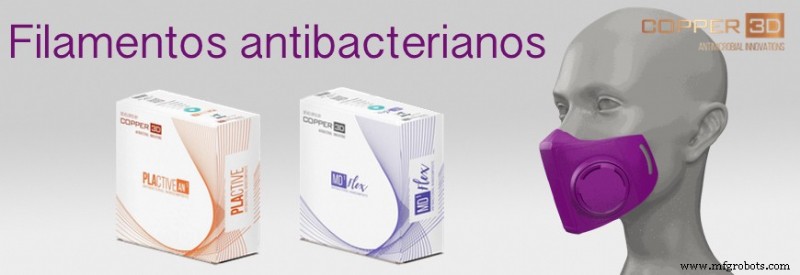
Common materials
For the manufacture of screens or valves that, due to their use, do not need to be composed of biocompatible or antibacterial materials, basic materials can be used in 3D FDM printing, such as PLA or PETG; since these elements do not require specific properties, although it's true that they require some rigidity and it's not recommended to use flexible materials such as Flexfill or FilaFlex.
With these free download files, any user with a FDM 3D printer and any of the aforementioned materials can contribute their bit to help stop the pandemic and the alarming situation we are currently experiencing.
3d Drucken
- Die 3 grundlegenden Schritte des 3D-Drucks
- 6 Möglichkeiten, die Kosten des 3D-Drucks zu senken
- 4 Dinge, die uns die COVID-19-Krise über den 3D-Druck sagt
- Die Rolle der Verschachtelung beim Polymer-3D-Druck
- Schnell und zuverlässig:MedTech-Lösungen inmitten der COVID-19-Pandemie
- Drucken der Sicherung 1 mit der Sicherung 1
- Mit 3D-Druck die Vergangenheit aufdecken
- COVID-19 hat 3D-Druck ins Rampenlicht gerückt
- Die Zukunft des 3D-Drucks in der Fertigung
- Ist 3D-Druck die Zukunft der Fertigung?



